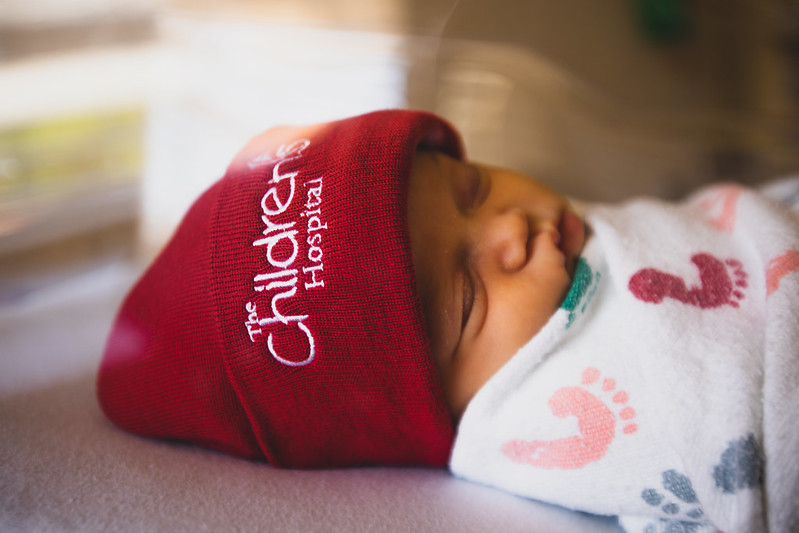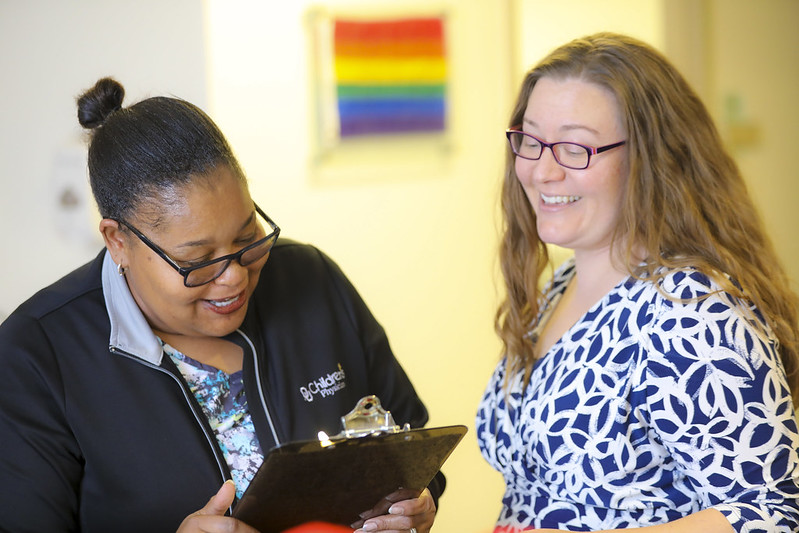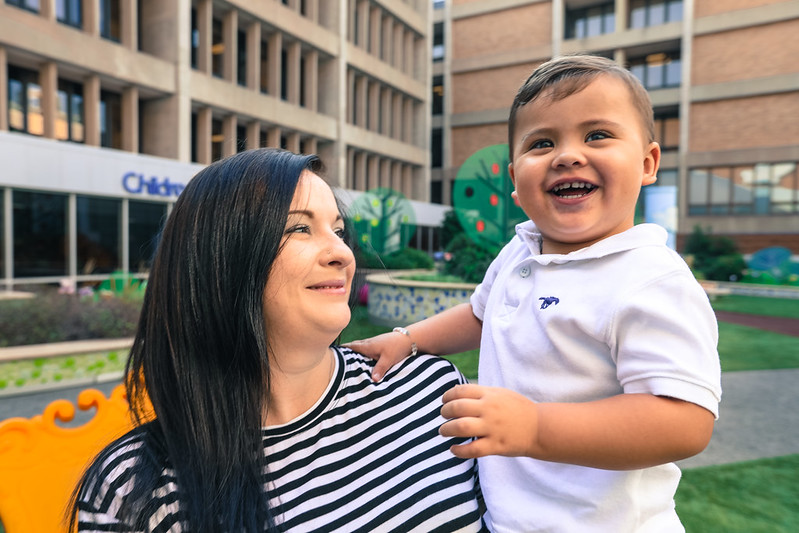
Our educational and clinical experiences are carefully researched and developed based on ACGME and ABP priorities and requirements, trends in healthcare, local resources, and dedicated expert faculty. We pride ourselves on hosting a variety of innovative electives based on unique career paths and the ever-changing needs of our learners. Across the inpatient and outpatient settings, our trainees are exposed to a wide range of pathology, providing the breadth and depth needed to address common pediatric diseases and complex diagnostic challenges.
Inpatient: Pediatric Hospital Medicine: Red and Blue Teams
Patients are admitted to one of two pediatric hospital medicine teaching services (Red Team, Blue Team). Residents rotate on these teams during all three years of their training. Interns are empowered to be the primary manager of their patients while upper-level residents assume a leadership role, overseeing and teaching interns and medical students. A pediatric attending physician supervises each service and leads daily teaching rounds, which feature family-centered rounding. Each service has a team census of up to 15 patients and features 2-3 interns and 1-2 upper-level residents. Colleagues from Family Medicine rotate with us during their intern years. As a teaching hospital, we are proud to have third- and fourth-year medical students and sub-I’s working and learning alongside us.
Inpatient: Subspecialty Services
Cardiology and Nephrology: Purple Team
Gastroenterology and Endocrinology: Orange Team
Each service has a team census of up to 15 patients and features 1-2 interns and 1-2 upper-level residents. Third- and fourth-year medical students and sub-I’s are members of these teams, too. Residents will work with fellows and attending physicians to care for primary patients and participate in consults.
Hematology/Oncology: Green Team
Residents spend one block rotating with our heme/onc inpatient service and bone marrow transplant service, which typically manages about 20 patients per day. Common diagnoses include leukemia, lymphoma, solid tumor, sickle cell disease, and hemophilia.
Night Float
Residents receive checkout from day services (General Pediatrics, Cardiology, Nephrology, Gastroenterology, Endocrinology, Hematology/Oncology) and provide overnight, in-house coverage, which includes attending to patient needs and working up new admissions. An attending physician is available in-house the entire night. Many residents feel the night rotation is when their clinical and management skills blossomed the most. Residents serve on the overnight service for 3-4 weeks a year; doing so eliminates the need for q4 call and helps our day-night balance

Newborn Nursery (Mom/Baby Unit or MBU)
Oklahoma Children's Hospital is home to over 4,000 deliveries each year and provides support for the only high-risk obstetrics service in the state. The MBU team attends all high-risk deliveries and administers Neonatal Resuscitation (NRP). Healthy, term infants are admitted to the MBU, where babies room-in with their families. Each resident completes this rotation as an intern and returns as a PGY-3 in a supervisory role.
Neonatal Intensive Care Unit (NICU)
Our NICU is a level IV Unit with 93 beds, including an ECMO suite. We are a state-wide referral center with over 1,200 admissions per year. Residents learn management of these high-risk, complex neonates during their PGY-1 and PGY-2 years. PGY2's also complete a week of overnight NICU coverage. Day or night, this rotation provides an excellent opportunity to gain procedural skills.
Pediatric Intensive Care Unit (PICU)
Redesigned and renovated in 2019, our 34-bed PICU is the largest in the state of Oklahoma and serves the majority of the state. Residents rotate through the PICU during their PGY-2 and PGY-3 years. Over a dozen board-certified PICU attendings provide in-house coverage 24 hours a day and practice family-centered rounding. Pediatric residents manage all medical patients on the resident team. The PICU provides firsthand training in the highest level of acuity and complexity of pediatric conditions including ECMO, post-transplant, and level 1 trauma care. There are frequent opportunities for procedures, including line placements, chest tubes, and intubations.
Residents interested in intensive care and cardiology can arrange an elective to rotate in our Cardiovascular Intensive Care Unit, which cares for children with complex cardiac pathology, many of whom are admitted to the Pediatric Cardiothoracic Surgery team, both pre- and post-operation.
Pediatric Emergency Medicine
Oklahoma Children's Hospital has the state’s only dedicated pediatric emergency department within the only freestanding children’s hospital in Oklahoma. The department serves as a referral center for children within our state and surrounding states as well. OU Health is also home to the state’s only American College of Surgeons Level One Pediatric Trauma Center. Our emergency department opened a new ten-bed expansion in March of 2024 for a total of 35 beds. Our pediatric residents primarily manage their own patients with the guidance of the PEM attendings and fellows. The department serves over 45,000 children each year.

Adolescent Medicine
Residents rotate with the Adolescent Medicine for one block during their PGY-2 year, where they have the unique opportunity to learn in the inpatient and outpatient setting. The outpatient clinic provides exposure to issues unique to adolescents, including high-risk behaviors, sexuality and birth control, mental health, and chronic illnesses.
Developmental/Behavioral Pediatrics (DBP)
Residents rotate with the DBP service to gain a better understanding of typical and atypical development. OU’s Child Study Center has multiple clinics centered on children with unique developmental needs, including in-utero exposure to drugs and alcohol (ABC Clinic, A Better Chance), full multidisciplinary evaluation for autism spectrum disorder (Jump Start Clinic), and ADHD, among others. Residents build on their education with visits to on- and off-campus community centers and Sooner Start, Oklahoma’s early childhood intervention program.
Complex Care
PGY-3 residents rotate at Bethany Children’s Health Center, a free-standing, nationally renowned complex for children with special health care needs. In addition to residential stay, children can receive short- or long-term rehabilitation services. Many attending physicians at Oklahoma Children’s Hospital also round regularly at Bethany Children's to provide consultative care.
General Pediatrics Clinic
The Sooner Pediatrics Clinic is the largest general primary care clinic at Oklahoma Children's Hospital and has over 22,000 patient visits per year. Additionally all residents spend one block in the Sooner Pediatrics clinic. The goal of this rotation is to provide every resident with a broad primary care pediatric experience, which includes well-child care, acute illness management, and exposure to complex diagnostic and social problems.
Second and Third year residents will also rotate through the Sooner Pediatrics North clinic during an X block rotation. This is our newest ambulatory clinic located in North Oklahoma City! It caters to a wide array of populations for a faster paced experience, similar to the pace of outpatient pediatric private practices, with all the support an academic institution has to offer.
Electives
Residents can prepare for their future careers through elective experiences that supplement their education. There is an extensive list of established electives, but residents are also able to craft their own electives to provide rich experiences that meet their educational goals.
All established rotations above are also available elective experiences. Residents interested in outpatient general pediatrics can rotate in the community with pediatric practices in urban, suburban, and rural settings. Trainees pursuing a subspecialty career can explore their field of interest in both the inpatient and outpatient settings. Residents who are interested in hospitalist medicine can rotate with attendings on the hospitalist service (Silver team) in both day or night settings; residents can also work with the Admit Officer to field calls from physicians and facilities across the state for potential admission to Oklahoma Children’s Hospital. Trainees can rotate with dietitians, lactation consultants, and physical, occupational, and speech therapists in inpatient and outpatient settings. Some other popular elective rotations include infectious disease, medical Spanish, procedures, sedation, anesthesiology, disaster preparedness, humanities, education, and the new parent elective. This is just a small sample of options — at a large teaching hospital like ours, the sky is the limit!
